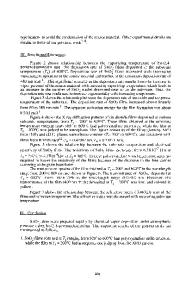Structure and chemical characteristics of tin oxide films prepared by reactive-ion-assisted deposition as a function of
- PDF / 863,176 Bytes
- 11 Pages / 612 x 792 pts (letter) Page_size
- 7 Downloads / 317 Views
Seok-Keun Koh and Hyung-Jin Jung Thin Film Technology Research Center, Korea Institute of Science and Technology, P.O. Box 131, Cheongryang, Seoul 130-650 Korea
Jeong-Young Lee Department of Materials Science and Engineering, Korea Advanced Institute of Science and Technology, Yousung Ku, Kusung Taejeon, Korea
Hong-Koo Baik Department of Metallurgical Engineering, Yonsei University, Seodamoon, Shinchon 134, Seoul 120-749, Korea (Received 11 January 1999; accepted 16 June 2000)
Tin oxide films were deposited on amorphous SiO2/Si and Si (100) substrates by ion-assisted deposition (IAD) at various ion beam potentials (VI) at room temperature and a working pressure of 8 × 10−5 torr. The structural and chemical properties of the as-grown tin oxide films were investigated to determine the effects of the oxygen ion/atom arrival ratio (Ri). X-ray diffraction patterns indicated that the as-grown films with different average energy per atom (Eave) showed different growth directions. The as-grown films with oxygen/Sn ratio (NO/NSn) of 2.03 and 2.02 had preferred orientation of (101) and (002), respectively. In addition, the as-grown film with low Ri was amorphous. Comparison of the observed d spacings with those for standard SnO2 samples, indicated that the crystalline as-grown films had compressive and tensile stress depending on Eave. In transmission electron microscopy analysis, a buffer layer of amorphous tin oxide was observed at the interface between the substrate and the film, and the crystalline grains were grown on this buffer layer. The crystalline grains were arranged in large spherical clusters, and this shape directly affected surface roughness. Rutherford backscattering spectroscopy spectra showed that the tin oxide thin films were inhomogeneous. The density of films decreased and the porosity and oxygen trapped in the films increased with increasing Ri. The densest film had about 6% porosity.
I. INTRODUCTION
Tin oxide thin films are particularly important for many device applications, such as in prototype gas sensors,1 catalyses,2, transparent conducting electrodes,3 and solar cells.4 Tin oxide thin films have been fabricated using many different techniques including spray pyrolysis of a solution of SnCl4,5,6 magnetic or radio frequency (RF) sputtering,7,8 ion beam sputtering,9 the sol-gel method,10 chemical vapor deposition,11,12 and thermal evaporation.13,14 Ion-assisted deposition (IAD) methods have many advantages, such as low-temperature film growth, smooth film surfaces, good control of crystallinity and composition, and fast nucleation of the material on the subJ. Mater. Res., Vol. 15, No. 9, Sep 2000
http://journals.cambridge.org
Downloaded: 13 Mar 2015
strate.15,16 IAD is especially useful for synthesizing oxide or nitride thin films because energetic gas particles can play both direct and indirect roles in film growth. Such an energetic ion bombardment can generate significant changes in crystal size and orientations, defect den-sities, electrical and optical properties, chemical stoichiometry
Data Loading...










